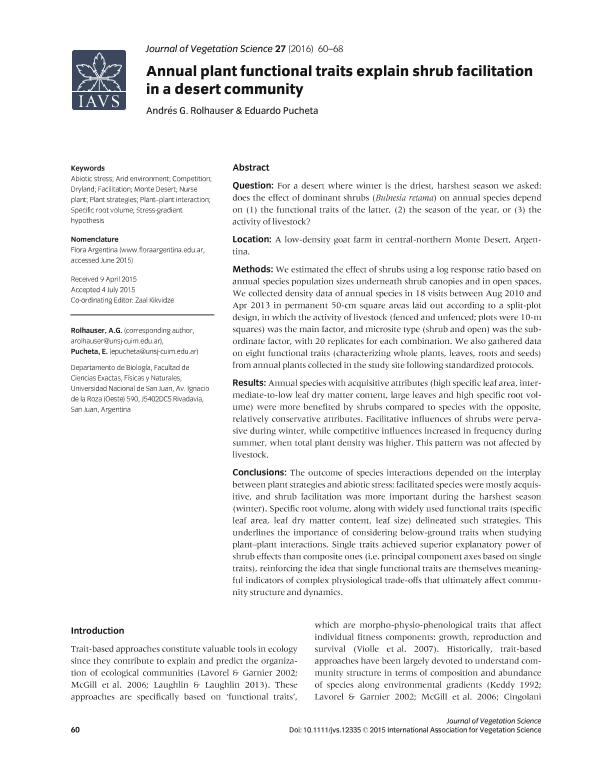Artículo
Annual plant functional traits explain shrub facilitation in a desert community
Fecha de publicación:
01/2016
Editorial:
Wiley Blackwell Publishing, Inc
Revista:
Journal of Vegetation Science
ISSN:
1100-9233
Idioma:
Inglés
Tipo de recurso:
Artículo publicado
Clasificación temática:
Resumen
Question: For a desert where winter is the driest, harshest season we asked: does the effect of dominant shrubs (Bulnesia retama) on annual species depend on (1) the functional traits of the latter, (2) the season of the year, or (3) the activity of livestock? Location: A low-density goat farm in central-northern Monte Desert, Argentina. Methods: We estimated the effect of shrubs using a log response ratio based on annual species population sizes underneath shrub canopies and in open spaces. We collected density data of annual species in 18 visits between Aug 2010 and Apr 2013 in permanent 50-cm square areas laid out according to a split-plot design, in which the activity of livestock (fenced and unfenced; plots were 10-m squares) was the main factor, and microsite type (shrub and open) was the subordinate factor, with 20 replicates for each combination. We also gathered data on eight functional traits (characterizing whole plants, leaves, roots and seeds) from annual plants collected in the study site following standardized protocols. Results: Annual species with acquisitive attributes (high specific leaf area, intermediate-to-low leaf dry matter content, large leaves and high specific root volume) were more benefited by shrubs compared to species with the opposite, relatively conservative attributes. Facilitative influences of shrubs were pervasive during winter, while competitive influences increased in frequency during summer, when total plant density was higher. This pattern was not affected by livestock. Conclusions: The outcome of species interactions depended on the interplay between plant strategies and abiotic stress: facilitated species were mostly acquisitive, and shrub facilitation was more important during the harshest season (winter). Specific root volume, along with widely used functional traits (specific leaf area, leaf dry matter content, leaf size) delineated such strategies. This underlines the importance of considering below-ground traits when studying plant-plant interactions. Single traits achieved superior explanatory power of shrub effects than composite ones (i.e. principal component axes based on single traits), reinforcing the idea that single functional traits are themselves meaningful indicators of complex physiological trade-offs that ultimately affect community structure and dynamics. Whether functional traits determine species' abundance within a given community remains unresolved. We show that ecological strategies of desert annuals determined their abundance in relation to dominant shrubs: acquisitive species were facilitated, whereas conservative ones were repelled. Specific root volume, along with widely used functional traits (specific leaf area, leaf dry matter content, and leaf size) delineated such annual-plant strategies.
Archivos asociados
Licencia
Identificadores
Colecciones
Articulos(IFEVA)
Articulos de INST.D/INV.FISIOLOGICAS Y ECO.VINCULADAS A L/AGRIC
Articulos de INST.D/INV.FISIOLOGICAS Y ECO.VINCULADAS A L/AGRIC
Citación
Rolhauser, Andrés Guillermo; Pucheta, Eduardo Raúl; Annual plant functional traits explain shrub facilitation in a desert community; Wiley Blackwell Publishing, Inc; Journal of Vegetation Science; 27; 1; 1-2016; 60-68
Compartir
Altmétricas
Items relacionados
Mostrando titulos relacionados por título, autor y tema.
-
Pissolito, Clara Ines ; Garibotti, Irene Adriana ; Varela, Santiago Agustín; Arana, Maria Veronica ; Gonzalez Polo, Marina ; Marchelli, Paula ; Bruzzone, Octavio Augusto (Copernicus Publications, 2019-04)
-
Artículo A calorimetric study of plant?plant and plant?soil interactions of extracts from Ixorhea tschudianaSesto Cabral, María Eugenia ; Schabes, Fanny Isabel; Sigstad, Emma Elizabeth (Elsevier Science, 2010-01)
-
Ferrari, Florencia Noemí ; Parera, Carlos; Passera, Carlos Bernardo (Instituto de Investigaciones Agropecuarias, 2016-03)




